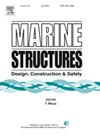稳定流动中挠性管道涡激振动的流固耦合仿真模型
IF 5.1
2区 工程技术
Q1 ENGINEERING, CIVIL
引用次数: 0
摘要
提出了一种基于条形法的柔性管道涡激振动流固耦合仿真框架。将数值计算结果与均匀流动、线性剪切流动和双向剪切流动三种稳定流动条件下的实验数据进行了比较。雷诺数范围为104 ~ 105。流场仿真基于开源软件OpenFOAM。固体场基于欧拉-伯努利梁有限元法建模,流固耦合通过MATLAB开发的弱耦合算法实现。涡激振动响应的评估是根据振幅和频率,以及应变的差异。此外,还研究了小波分析和行波现象。本文首次对双向剪切流作用下柔性管的涡激振动进行了数值模拟,并与实验数据进行了对比验证。与均匀和线性剪切流动相比,双向剪切流动条件下的行波行为更明显,多频响应更强,尤其是在直线方向上。模拟结果与实测应变数据进行了直接比较,在不同的流动条件下显示出一致性。本文的数值模拟代码和实验数据是公开的,为今后更复杂的涡激振动模拟奠定了基础。本文章由计算机程序翻译,如有差异,请以英文原文为准。
A validated fluid–structure interaction simulation model for vortex-induced vibration of a flexible pipe in steady flow
We propose a validated fluid–structure interaction simulation framework based on the strip method for the vortex-induced vibration of a flexible pipe. The numerical results are compared with the experimental data from three steady flow conditions: uniform, linearly sheared, and bidirectionally sheared flow. The Reynolds number ranges from to . The flow field is simulated based on open-source software OpenFOAM. The solid field is modeled based on the finite element method of the Euler–Bernoulli beam, and fluid–structure coupling is implemented via a weak coupling algorithm developed in MATLAB. The vortex-induced vibration response is assessed in terms of amplitude and frequency, along with the differences in strain. Additionally, wavelet analysis and traveling wave phenomena are investigated. This study presents the first numerical simulation of flexible pipe VIV under bidirectionally sheared flow, validated against experimental data. Compared to uniform and linearly sheared flow, the bidirectionally sheared flow condition leads to more pronounced traveling wave behavior and stronger multi-frequency responses, especially in the in-line direction. The simulation results are directly compared with measured strain data, showing agreement across different flow conditions. The numerical simulation codes and experimental data in this manuscript are openly available, providing a foundation for more complex vortex-induced vibration simulations in the future.
求助全文
通过发布文献求助,成功后即可免费获取论文全文。
去求助
来源期刊

Marine Structures
工程技术-工程:海洋
CiteScore
8.70
自引率
7.70%
发文量
157
审稿时长
6.4 months
期刊介绍:
This journal aims to provide a medium for presentation and discussion of the latest developments in research, design, fabrication and in-service experience relating to marine structures, i.e., all structures of steel, concrete, light alloy or composite construction having an interface with the sea, including ships, fixed and mobile offshore platforms, submarine and submersibles, pipelines, subsea systems for shallow and deep ocean operations and coastal structures such as piers.
 求助内容:
求助内容: 应助结果提醒方式:
应助结果提醒方式:


